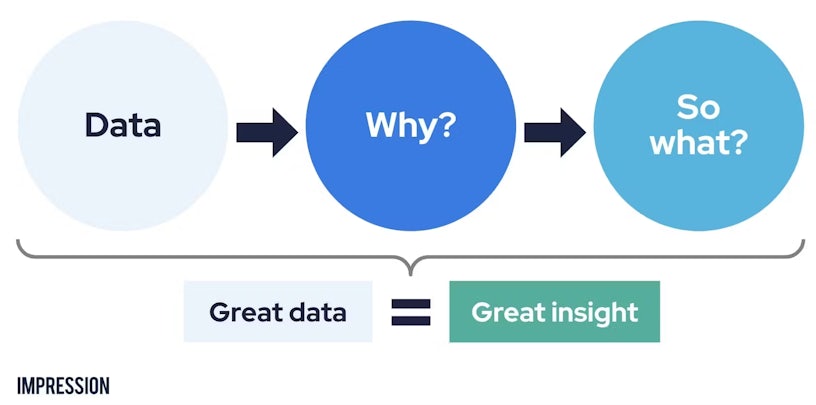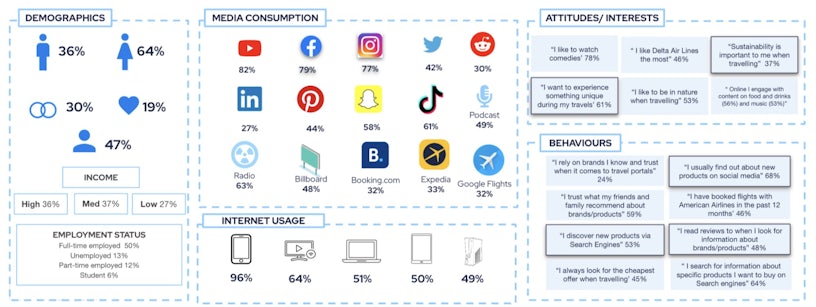For any digital marketer, leveraging marketing insights are vital when it comes to formulating a strong digital marketing strategy. But what makes them so important, how do you derive useful information from data, and how can you collect these insights?
In this blog, we’ll look at all of these topics, including methods for data gathering, as well as, how you can incorporate insights to inform your next strategy.
- What are marketing insights, and why are they important?
- What are marketing insights?
- Why are marketing insights important?
- Key marketing insights and how to gather them
- First-party insights
- Third-party insights
- Interpreting data and deriving insights
- How to use insights to inform your next digital strategy
What are marketing insights, and why are they important?
What are marketing insights?
Marketing insight, in definition, is a piece of relevant, actionable, and credible information you get from analysing data of economic situations, industries, competitors, consumer behaviour and businesses themselves; that supports you in making marketing strategy decisions. Good marketing insights will benefit businesses to reach their target audience in the right places, at the right time, with suitable marketing budgets.
According to Statista, organisations utilising insights to make data-driven decisions increased by 12% from 2018 to 2020 worldwide, with 69% of organisations in the UK in 2020.
Data is the lifeblood of your business
Tom Hutchinson | The Drum
Why are marketing insights important?
So, now you know that marketing insights are and that business are increasingly relying on them to make decisions, but why? There are a lot of benefits of utilising insights in marketing strategies, below we’ve listed some examples why they’re useful and of how you can put into practice:
- They can improve the customer experience : Good insights can help you to personalised marketing strategies, to align with your audience profiles that inform your decisions around messaging and channel selection, for example.
- Benchmarking against competitors: From battling against what competitors doing to where they are doing well, will provide you with a position on where you sit within your industry’s marketing. Utilising this data will provide you with avenues test new campaigns and can help inform budget for upcoming strategies. In long-term it can map our directions on how you may be able to steal market share.
- Provide data to optimise campaigns to increase potential ROI:Leveraing first-party insights such as campaign data, revenue and conversion rates can in the long-term help evaluate performance and can identify areas for improvement. Combining this with third-party insights can signal how the industry is performing overall to benchmark performance.
Key marketing insights and how to gather them
By having access to a wide range of data through first-party and third-party sources, marketers can have a wealth of insights to utilise. However, depending on your business and marketing objectives, you can leverage different resources to explore insights that are most relevant. It’s also essential to ensure that data included in reports are creditable before taking any decisions, making any conclusions, or sharing with other stakeholders
First-party insights
First-party insights come from analysing data and information that you collect first-hand. To collect first-party insights, you can utilise existing data in CRM systems, Google Analytics (GA) tracking, conduct customer surveys and much more. Especially in digital marketing, optimising GA tracking setup will enhance the quality of your insights. Find out more about Google Analytics and data solutions here.
There are two key types of insights that you will want to look for: Marketing Performance and Current Customer Profiles. Understanding this data will help you to evaluate your current situation and compare it to the market.
Marketing Performance Insights marketers should keep an eye on:
- Total traffic and traffic breakdown by channels, products/services
- Total costs and costs breakdown by channels
- Revenue and revenue breakdown by channels, products/services
From this information, you can evaluate the return rate in the short-term and long-term, and if they align with marketing objectives and business objectives.
Current Customer Insights
- Demographics – Such as age, location, income, for example
- Channels usage – Understand how users arrived at your website or which channel drive them making purchases.
- Purchase behaviour and purchase experience – Ciscover touchpoints that lead them to your brand and why they decide to make the payments.
- Website scroll behaviour
First-party insight limitations:
- You will need consent to use consumer data (i.e through the use of cookie consent banners)
- The quality of sampling groups for consumer behaviour can be limited – not every customer is expected to fill out a survey
- Focuses on the business itself, lacks a wider holistic point of view
Third-party insights
Third-party insights are data and information collected by a business or company with no direct relationship with you or the customer. These are resources that you can look at such as Public Reports and Paid Reports released by researchers/research companies or third-party data tools such as Similarweb, Statista, and GWI.
Key types of insights you can collect from third-party providers: Market Insights, Competitors Insights and Consumer Profiles. These can be broken down into:
Market Insights
- The traffic/revenue trends of the market during the past years
- Forecast traffic/revenue of the industry’s performance in upcoming years
- Any rising players – collect information on any companies having significant traffic/revenue growth
Competitor Insights
- Traffic Distribution by Channels – to understand their marketing mix strategy
- Traffic Volume for each Channel – to know where they perform well which might help us to discover new opportunities
- Their audience demographics – to understand if they compete directly with us
- Their budgets for media channels – to evaluate the correlation between their spending and their performance
Consumer Insights:
Before going to find your target audience’s behaviour, you need to know who is your target audience with some simple variables. For example Location, Age or Income. Then discover more about them, for example:
- Demographics
- Media Usage: Radio, TV, etc
- Social Network Usage
- Who or what are they following on online
- Interests
- Beliefs
- Attitude towards Marketing touchpoints
- Attitude towards the industry/product
- Search volume of your products/industry in Search Engine
- Search volume of your brand in Search Engine

Third-party insights limitations:
- The figures from third-party tools can be relative. We recommend looking at the trends of the data for further insigth
- Depending on your sources, quality third-party data collection can be costly, but this can be a highly-beneficial investment
There are always pros and cons in using first and third-party insights, yet they can support each other perfectly if you know how to combine them together which can be valuable reference points to lean on when formulating marketing strategies.
Interpreting data and deriving insights
So, now you have your data in hand, the next step is to read them and make statements from that information.
A simple formula to follow is:

Below are some simple examples of how you can interpret your insights:
- Brand Performance
“Traffic from Social has been increasing in the last 4 months by 30%.” This may be because we have posted content regularly and increased Meta ads budget. This showacases this is an effective channel that we are performing well. Investing more in the quality of the content (consistent tone of voice, appealing images, etc) on social media and Meta Ads budget is recommended.
- Market/Industry Insights
“The market is forecasted to be growing significantly in the next 3 years.” This could mean that the brands need to be more aggressive in marketing activities to drive new audiences and gain market share.
- Competitor Insights
“Brand X is utilising Tiktok and saw a growth in Social traffic by 50% last month.” This may be because they just collaborated with an influencer. This means Tiktok content can benefit us by increasing visibility and brand awareness.
- Consumer Insights
“60% of our audience uses Tiktok.” This means TikTok is a potential channel to run both Organic and Paid activities. This also provides avenues for you to look at how you can best target the remaining 40%.
How to use insights to inform your next digital strategy
Now you have in mind what your insights mean. Here’s how you can combine those pieces of information and put them into your next digital strategy
- Market Insights (Third Party) + Competitor Insights + Internal Insights
- Set Objectives
- Audience Profile (align with objectives) (using first + third-party data)
- Channel Selection + Messaging
- Budgeting
- Execute and repeat
Continue with the previous examples, here is a simple process of utilising insights in your strategy
- The demand is growing, Social Traffic has been increasing by 30% and A competitor is driving traffic from Tiktok
- Objective: To increase Social Traffic by 30% in the next 6 months
- 60% of our target audience using Tiktok
- In the next 6 months, we will invest in organic and paid activities on Tiktok
- Spending £xx on Paid Tiktok and collaborating with influencers in organic content
- Execute and repeat
For blogs on digital marketing strategy, click here. If you have any questions about how to best utilise first and third-party data, get in touch.





